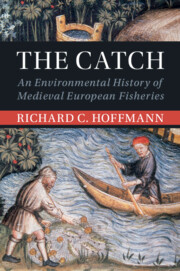Book contents
- The Catch
- Studies in Environment and History
- The Catch
- Copyright page
- Dedication
- Additional material
- Contents
- List of Figures
- List of Maps
- Preface and Acknowledgements
- Abbreviations Used in Notes and Bibliography
- Introduction
- 1 “Natural” Aquatic Ecosystems around Late Holocene Europe
- 2 Protein, Penance, and Prestige
- 3 Take and Eat
- 4 Master Artisans and Local Markets
- 5 Aquatic Systems under Stress, c. 1000–1350
- 6 Cultural Responses to Scarcities of Fish
- 7 Going beyond Natural Local Ecosystems, I
- 8 Going beyond Natural Local Ecosystems, II
- 9 Last Casts
- Appendix A Glossary of European Fishes Named in This Book
- References
- Index
8 - Going beyond Natural Local Ecosystems, II
Over the Horizon toward Abundance and ‘Tragedy’1
Published online by Cambridge University Press: 11 May 2023
- The Catch
- Studies in Environment and History
- The Catch
- Copyright page
- Dedication
- Additional material
- Contents
- List of Figures
- List of Maps
- Preface and Acknowledgements
- Abbreviations Used in Notes and Bibliography
- Introduction
- 1 “Natural” Aquatic Ecosystems around Late Holocene Europe
- 2 Protein, Penance, and Prestige
- 3 Take and Eat
- 4 Master Artisans and Local Markets
- 5 Aquatic Systems under Stress, c. 1000–1350
- 6 Cultural Responses to Scarcities of Fish
- 7 Going beyond Natural Local Ecosystems, I
- 8 Going beyond Natural Local Ecosystems, II
- 9 Last Casts
- Appendix A Glossary of European Fishes Named in This Book
- References
- Index
Summary
Late medieval Europeans extended exploitation of fish stocks to marine frontiers previously little affected by intense human predation. Driven by demand since the twelfth century and supported by waves of innovative capture and preservation methods, herring fisheries in the North Sea and Baltic fed millions of northern Europeans with the largest medieval catches known. Stockfish (naturally freeze-dried cod) from arctic Norway went from a regional subsistence product c.1100 to an export trade profiting fishers and merchants alike. Elsewhere entrepreneurs caught, preserved, and exported pike and other fish from the eastern Baltic, hake and conger from the Channel approaches and Bay of Biscay, and migratory bluefin tuna off Sicily and the Gulf of Cadiz, all for consumption a thousand and more kilometers away. Transforming local abundances for distant tables at unprecedented scale drove new capitalized forms of organization and market behaviour. Consumers, merchants, and fishers saw fish as economic objects disconnected from any familiar nature and free for competitive exploitation. Yet besides prospects of infinite abundance the new frontier fisheries posed risks, and not simply those of hazardous access or human conflict. Heavily fished local stocks of herring successively crashed to commercial insignificance when further stressed by environmental changes in the pulsating arrival of the Little Ice Age. But the almost accidental discovery of virgin cod stocks off Newfoundland in the 1490s confirmed the mythic belief that abundance always lay over the next horizon. Thoughts of limits vanished at the eve of modernity.
Keywords
- Type
- Chapter
- Information
- The CatchAn Environmental History of Medieval European Fisheries, pp. 316 - 402Publisher: Cambridge University PressPrint publication year: 2023

